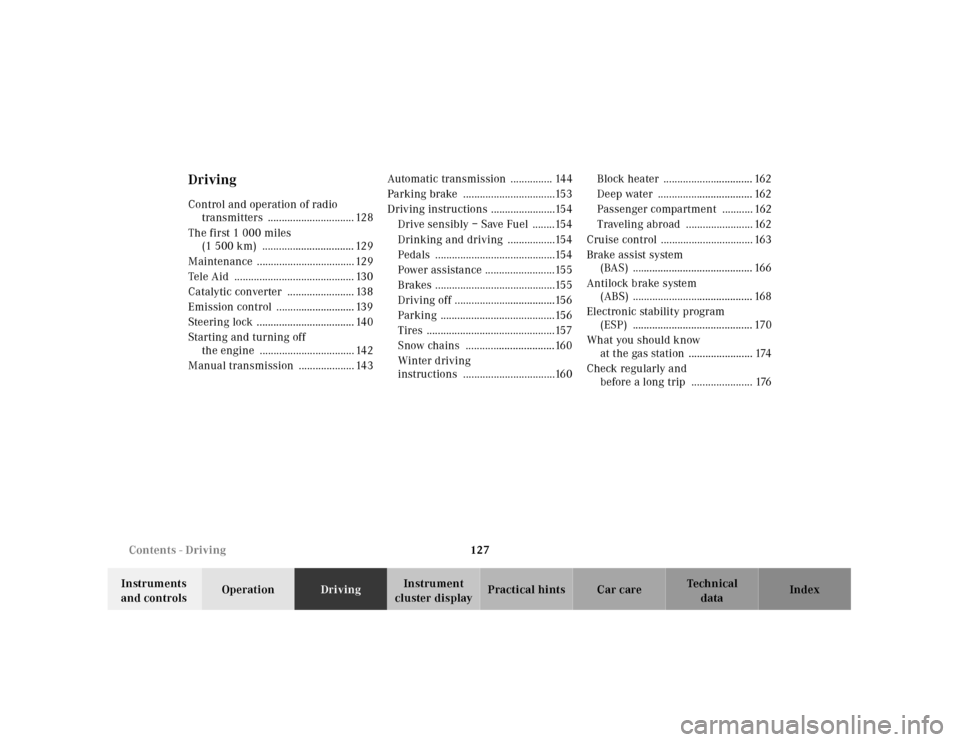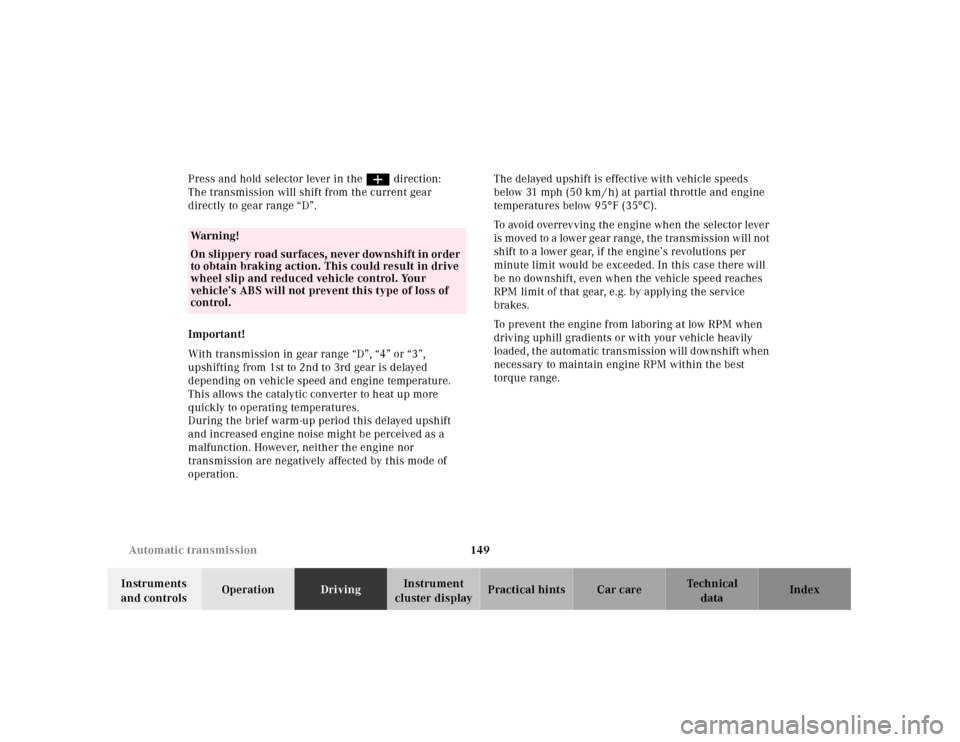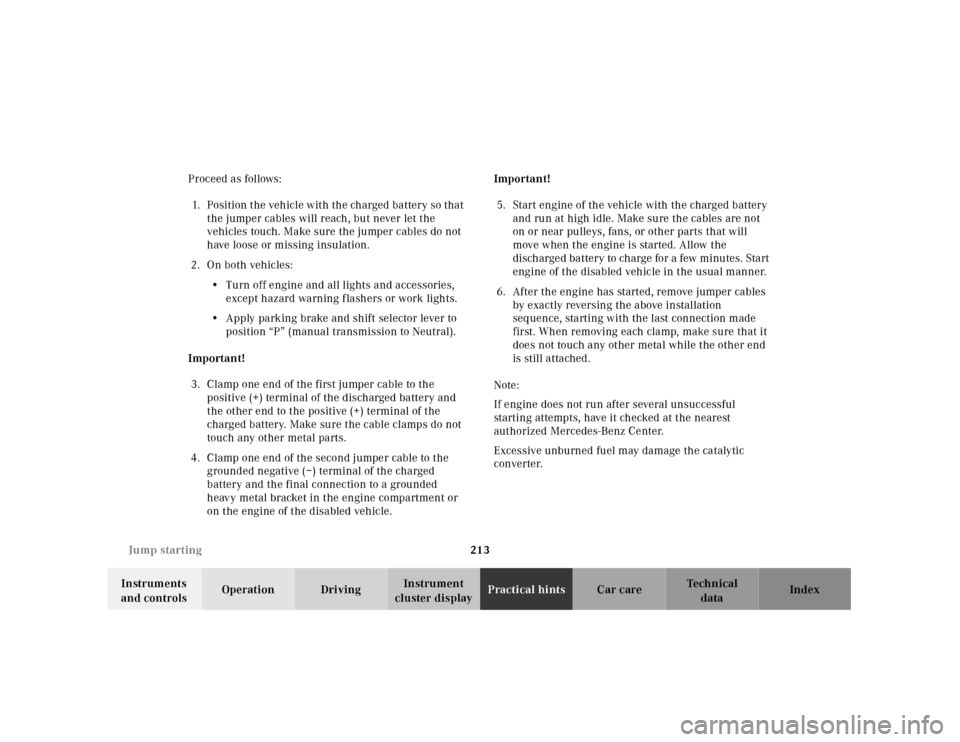2001 MERCEDES-BENZ SLK-Class catalytic converter
[x] Cancel search: catalytic converterPage 5 of 273

2 Contents
Power windows ............................... 109
Interior lighting ..............................110
Night security illumination ..........110
Sun visors with Vanity Mirror ......111
Interior .............................................111
Cup holder and glove box ............. 112
Storage compartments ...................113
Ashtrays ...........................................114
Coin Holder ......................................114
Lighter ..............................................115
Parcel net in
passenger footwell .....................116
Shelf behind roll bars .....................116
Cellular telephone ..........................116
Garage door opener ........................117
Retractable hardtop ....................... 120
Wind screen .................................... 125
Luggage cover ................................. 126
DrivingControl and operation
of radio transmitters ................ 128
The first 1 000 miles
(1 500 km) ................................. 129
Maintenance .................................. 129
Tele Aid ............................................130
Catalytic converter .........................138
Emission control .............................139
Steering lock .................................. 140
Starting and turning off
the engine .................................. 142
Manual transmission .................... 143
Automatic transmission ............... 144
Parking brake .................................153
Driving instructions .......................154
Drive sensibly – Save Fuel ........154
Drinking and driving .................154
Pedals ...........................................154Power assistance ........................ 155
Brakes .......................................... 155
Driving off ................................... 156
Parking ........................................ 156
Tires ............................................. 157
Snow chains ................................ 160
Winter driving instructions ...... 160
Block heater ................................ 162
Deep water .................................. 162
Passenger compartment ........... 162
Traveling abroad ........................ 162
Cruise control ................................. 163
Brake assist system (BAS) ............ 166
Antilock brake system (ABS) ....... 168
Electronic stability
program (ESP) ........................... 170
What you should know
at the gas station ....................... 174
Check regularly and
before a long trip ...................... 176
Page 12 of 273

9 IntroductionOperating your vehicle outside the USA or Canada
If you plan to operate your vehicle in foreign countries, please be aware that:
•Service facilities or replacement parts may not be readily available,
•unleaded gasoline for vehicles with catalytic converters may not be available; the use of leaded fuels will damage
the catalysts,
•gasoline may have a considerably lower octane rating, and improper fuel can cause engine damage.
Certain Mercedes-Benz models are available for delivery in Europe under our European Delivery Program. For details,
consult your authorized Mercedes-Benz Center or write to:
In the USA: In Canada:
Mercedes-Benz USA, LLC
European Delivery Department
One Mercedes Drive
Montvale, NJ 07645-0350Mercedes-Benz Canada, Inc.
European Delivery Department
849 Eglinton Avenue East
Toronto, Ontario M4G 2L5
Page 80 of 273

77 Checking engine oil level
Te ch n ica l
data Instruments
and controlsOperationDrivingInstrument
cluster displayPractical hints Car care Index Checking engine oil level
(model SLK 320)
Turn electronic key in steering lock to position 2 and
wait until the symbols : and I appear in the
odometer display field.
Within 1 second press left button on the instrument
cluster twice.The following messages are available:
“OK”
“-1.0 Q” (Canada: -1.0 L)
“-1.5 Q” (Canada: -1.5 L)
“-2.0 Q” (Canada: -2.0 L)
If the message “-2.0 Q” (Canada: -2.0 L) blinks and a
signal sounds, add oil to upper (max) mark of the
dipstick.
“HI”
The message “HI” blinks and a signal sounds.
Do not overfill the engine.
Excessive oil must be drained or siphoned. It could
cause damage to engine and catalytic converter not
covered by the Mercedes-Benz Limited Warranty.
The symbol I f la sh es in th e od ome ter display f ield if
a proper oil level check cannot be performed.
The oil level check can be repeated after a short time.
Perform the oil level check with the dipstick, if it cannot
be compl eted via t he od ometer display f iel d. In t his case
we recommend that you have the system checked at a
Mercedes-Benz Center.
Page 130 of 273

127 Contents - Driving
Te ch n ica l
data Instruments
and controlsOperationDrivingInstrument
cluster displayPractical hints Car care Index
DrivingControl and operation of radio
transmitters ............................... 128
The first 1 000 miles
(1 500 km) ................................. 129
Maintenance ................................... 129
Tele Aid ........................................... 130
Catalytic converter ........................ 138
Emission control ............................ 139
Steering lock ................................... 140
Starting and turning off
the engine .................................. 142
Manual transmission .................... 143Automatic transmission ............... 144
Parking brake .................................153
Driving instructions .......................154
Drive sensibly – Save Fuel ........154
Drinking and driving .................154
Pedals ...........................................154
Power assistance .........................155
Brakes ...........................................155
Driving off ....................................156
Parking .........................................156
Tires ..............................................157
Snow chains ................................160
Winter driving
instructions .................................160Block heater ................................ 162
Deep water .................................. 162
Passenger compartment ........... 162
Traveling abroad ........................ 162
Cruise control ................................. 163
Brake assist system
(BAS) ........................................... 166
Antilock brake system
(ABS) ........................................... 168
Electronic stability program
(ESP) ........................................... 170
What you should know
at the gas station ....................... 174
Check regularly and
before a long trip ...................... 176
Page 141 of 273

138 Catalytic converter
Te ch n ica l
data Instruments
and controlsOperationDrivingInstrument
cluster displayPractical hints Car care Index
Catalytic converter
Your Mercedes-Benz is equipped with monolithic type
catalytic converters, an important element in
conjunction with the oxygen sensors to achieve
substantial control of the pollutants in the exhaust
emissions. Keep your vehicle in proper operating
condition by following our recommended maintenance
instructions as outlined in your Service Booklet.
Caution!
To prevent damage to the catalytic converters, use only
premium unleaded gasoline in this vehicle.
Any noticeable irregularities in engine operation should
be repaired promptly. Otherwise, excessive unburned
fuel may reach the catalytic converter causing it to
overheat, which could start a fire.
Wa r n i n g !
As with any vehicle, do not idle, park or operate
this vehicle in areas where combustible materials
such as grass, hay or leaves can come into contact
with the hot exhaust system, as these materials
could be ignited and cause a vehicle fire.
Page 152 of 273

149 Automatic transmission
Te ch n ica l
data Instruments
and controlsOperationDrivingInstrument
cluster displayPractical hints Car care Index Press and hold selector lever in the æ direction:
The transmission will shift from the current gear
directly to gear range “D”.
Important!
With transmission in gear range “D”, “4” or “3”,
upshifting from 1st to 2nd to 3rd gear is delayed
depending on vehicle speed and engine temperature.
This allows the catalytic converter to heat up more
q uickly to operating temperatures.
During the brief warm-up period this delayed upshift
and increased engine noise might be perceived as a
malfunction. However, neither the engine nor
transmission are negatively affected by this mode of
operation.The delayed upshift is effective with vehicle speeds
below 31 mph (50 km / h) at partial throttle and engine
temperatures below 95°F (35°C).
To avoid overrevving the engine when the selector lever
is moved to a lower gear range, the transmission will not
shift to a lower gear, if the engine’s revolutions per
minute limit would be exceeded. In this case there will
be no downshift, even when the vehicle speed reaches
RPM limit of that gear, e.g. by applying the service
brakes.
To prevent the engine from laboring at low RPM when
driving uphill gradients or with your vehicle heavily
loaded, the automatic transmission will downshift when
necessary to maintain engine RPM within the best
torque range.
Wa r n i n g !
On slippery road surfaces, never downshift in order
to obtain braking action. This could result in drive
wheel slip and reduced vehicle control. Your
vehicle’s ABS will not prevent this type of loss of
control.
Page 216 of 273

213 Jump starting
Te ch n ica l
data Instruments
and controlsOperation DrivingInstrument
cluster displayPractical hintsCar care Index Proceed as follows:
1.Position the vehicle with the charged battery so that
the jumper cables will reach, but never let the
vehicles touch. Make sure the jumper cables do not
have loose or missing insulation.
2.On both vehicles:
•Turn off engine and all lights and accessories,
except hazard warning flashers or work lights.
•Apply parking brake and shift selector lever to
position “P” (manual transmission to Neutral).
Important!
3.Clamp one end of the first jumper cable to the
positive (+) terminal of the discharged battery and
the other end to the positive (+) terminal of the
charged battery. Make sure the cable clamps do not
touch any other metal parts.
4.Clamp one end of the second jumper cable to the
grounded negative (–) terminal of the charged
battery and the final connection to a grounded
heavy metal bracket in the engine compartment or
on the engine of the disabled vehicle.Important!
5.Start engine of the vehicle with the charged battery
and run at high idle. Make sure the cables are not
on or near pulleys, fans, or other parts that will
move when the engine is started. Allow the
discharged battery to charge for a few minutes. Start
engine of the disabled vehicle in the usual manner.
6.After the engine has started, remove jumper cables
by exactly reversing the above installation
sequence, starting with the last connection made
first. When removing each clamp, make sure that it
does not touch any other metal while the other end
is still attached.
Note:
If engine does not run after several unsuccessful
starting attempts, have it checked at the nearest
authorized Mercedes-Benz Center.
Excessive unburned fuel may damage the catalytic
converter.
Page 264 of 273

261 Index
Te ch n ica l
data Instruments
and controlsOperation DrivingInstrument
cluster displayPractical hints Car careIndex Brake assist system (BAS) ............................................ 166
Malfunction indicator lamp ..................................... 181
Brake fluid ......................................................................254
Brake pad wear indicator lamp .................................... 180
Brake warning lamp ...................................................... 179
Brake fluid low .......................................................... 179
Brakes .....................................................155, 166, 168, 170
CCapacities
Fuels, coolants, lubricants etc. ...............................252
Catalytic converter ........................................................ 138
Cellular telephone ..........................................................116
Center console .................................................................. 18
Central locking switch .................................................... 30
Central locking system ................................................... 25
Automatic central locking ......................................... 31
Choosing global or selective mode ........................... 26
Emergency release for trunk lid ............................... 35
General notes ............................................................... 24
Locking and unlocking .............................................. 26
Remote control ............................................ 22, 25, 224
Vehicle keys ................................................................. 22Changing wheels ........................................................... 202
Inflating the collapsible spare tire ........................ 207
Storing spare wheel in wheel well ........................ 208
Charge indicator lamp ................................................... 184
Check engine malfunction indicator lamp .................178
Check regularly and before a long trip ....................... 176
Checking engine oil level
Via engine oil level .....................................................77
Via oil dipstick ........................................................... 193
Child restraint ...............................................44, 50, 51, 61
Cleaning and care of the vehicle ................................ 234
Climate control .................................................................84
Air Recirculation .........................................................89
Basic setting .................................................................86
Defogging windows .....................................................87
Defrosting .....................................................................87
Dust Filter .....................................................................90
Rear window defroster ............................................... 88
Residual Engine Heat Utilization (REST) ................ 89
Special settings ........................................................... 87
Clock, setting .................................................................... 74
Coin Holder ..................................................................... 114
Combination switch ......................................................... 81
Consumer information ................................................. 258
Control and operation of radio transmitters .............. 128